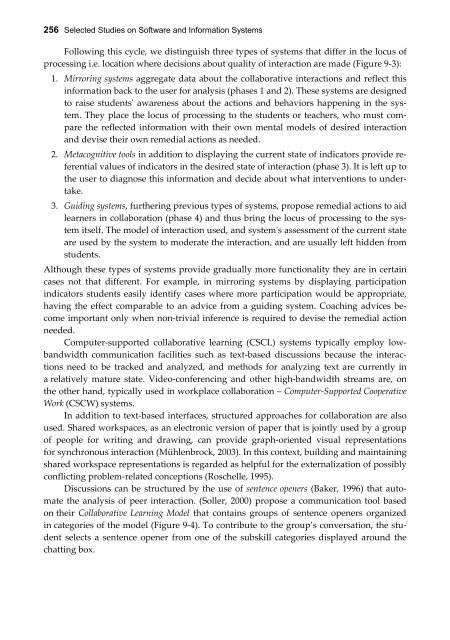elektronická verzia publikácie - FIIT STU - Slovenská technická ...
elektronická verzia publikácie - FIIT STU - Slovenská technická ...
elektronická verzia publikácie - FIIT STU - Slovenská technická ...
Create successful ePaper yourself
Turn your PDF publications into a flip-book with our unique Google optimized e-Paper software.
256 Selected Studies on Software and Information Systems<br />
Following this cycle, we distinguish three types of systems that differ in the locus of<br />
processing i.e. location where decisions about quality of interaction are made (Figure 9-3):<br />
1. Mirroring systems aggregate data about the collaborative interactions and reflect this<br />
information back to the user for analysis (phases 1 and 2). These systems are designed<br />
to raise students' awareness about the actions and behaviors happening in the system.<br />
They place the locus of processing to the students or teachers, who must compare<br />
the reflected information with their own mental models of desired interaction<br />
and devise their own remedial actions as needed.<br />
2. Metacognitive tools in addition to displaying the current state of indicators provide referential<br />
values of indicators in the desired state of interaction (phase 3). It is left up to<br />
the user to diagnose this information and decide about what interventions to undertake.<br />
3. Guiding systems, furthering previous types of systems, propose remedial actions to aid<br />
learners in collaboration (phase 4) and thus bring the locus of processing to the system<br />
itself. The model of interaction used, and system's assessment of the current state<br />
are used by the system to moderate the interaction, and are usually left hidden from<br />
students.<br />
Although these types of systems provide gradually more functionality they are in certain<br />
cases not that different. For example, in mirroring systems by displaying participation<br />
indicators students easily identify cases where more participation would be appropriate,<br />
having the effect comparable to an advice from a guiding system. Coaching advices become<br />
important only when non-trivial inference is required to devise the remedial action<br />
needed.<br />
Computer-supported collaborative learning (CSCL) systems typically employ lowbandwidth<br />
communication facilities such as text-based discussions because the interactions<br />
need to be tracked and analyzed, and methods for analyzing text are currently in<br />
a relatively mature state. Video-conferencing and other high-bandwidth streams are, on<br />
the other hand, typically used in workplace collaboration – Computer-Supported Cooperative<br />
Work (CSCW) systems.<br />
In addition to text-based interfaces, structured approaches for collaboration are also<br />
used. Shared workspaces, as an electronic version of paper that is jointly used by a group<br />
of people for writing and drawing, can provide graph-oriented visual representations<br />
for synchronous interaction (Mühlenbrock, 2003). In this context, building and maintaining<br />
shared workspace representations is regarded as helpful for the externalization of possibly<br />
conflicting problem-related conceptions (Roschelle, 1995).<br />
Discussions can be structured by the use of sentence openers (Baker, 1996) that automate<br />
the analysis of peer interaction. (Soller, 2000) propose a communication tool based<br />
on their Collaborative Learning Model that contains groups of sentence openers organized<br />
in categories of the model (Figure 9-4). To contribute to the group’s conversation, the student<br />
selects a sentence opener from one of the subskill categories displayed around the<br />
chatting box.

















